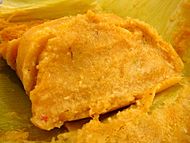Kānga waru facts for kids
 |
|
| Alternative names | Corn pudding, Corn and kūmara pudding |
|---|---|
| Type | Pudding |
| Course | Dessert |
| Associated national cuisine | New Zealand |
| Main ingredients | Corn, Sweet potato |
Kānga waru is a delicious and traditional pudding from New Zealand. This sweet treat is a special part of Māori cuisine, made by the Māori people, who are the native people of New Zealand. It's created from a dough of cornmeal that is carefully wrapped and then steamed until it's perfectly cooked.
What's in a Name?
The name Kānga waru tells us a lot about this pudding!
- Kānga is the Māori word for corn. It's very similar to the English word, showing how the Māori language adopted new words.
- Waru comes from an old Polynesian word that means to scrape. This refers to one of the traditional ways people prepared puddings by scraping ingredients.
Corn was not originally from New Zealand. Early European settlers brought corn to the country, and the Māori people quickly started growing it as an important food crop. They became very creative with corn, making many different dishes. For example, they made Kānga pirau, which is fermented corn, and Kānga pungarehu, which means corn cooked in ash.
How Is Kānga Waru Made?
Making Kānga waru involves mixing a few simple ingredients to create a tasty pudding.
Ingredients for Kānga Waru
The main ingredients for Kānga waru are:
- Corn (which can be grated fresh or used as cornmeal)
- Flour
- Sugar
- Butter
- Milk
- Grated kūmara (which is the Māori word for sweet potato)
All these ingredients are mixed together until they form a soft dough.
Cooking Kānga Waru
Once the dough is ready, it's wrapped up and steamed. Traditionally, Māori people would wrap the dough in corn husks. Then, they would cook it in a hāngi. A hāngi is a special underground oven where food is cooked slowly over hot rocks. It gives the food a unique, smoky flavor.
Today, people often use modern methods to cook Kānga waru. They might wrap the dough in foil instead of corn husks. Then, they steam it in a pot, much like how other steamed puddings are made. This makes it easier to prepare at home while still keeping the traditional taste.

